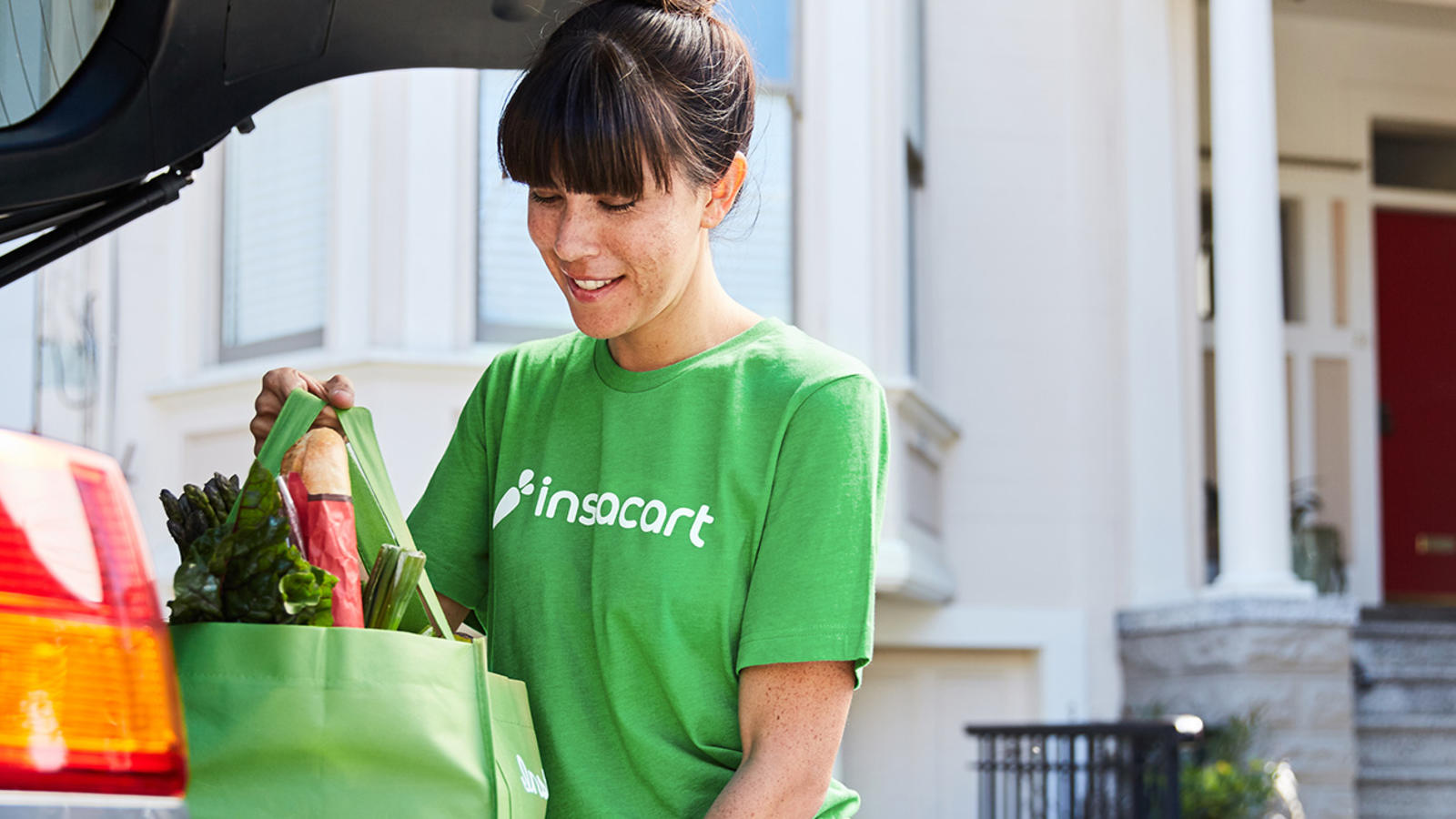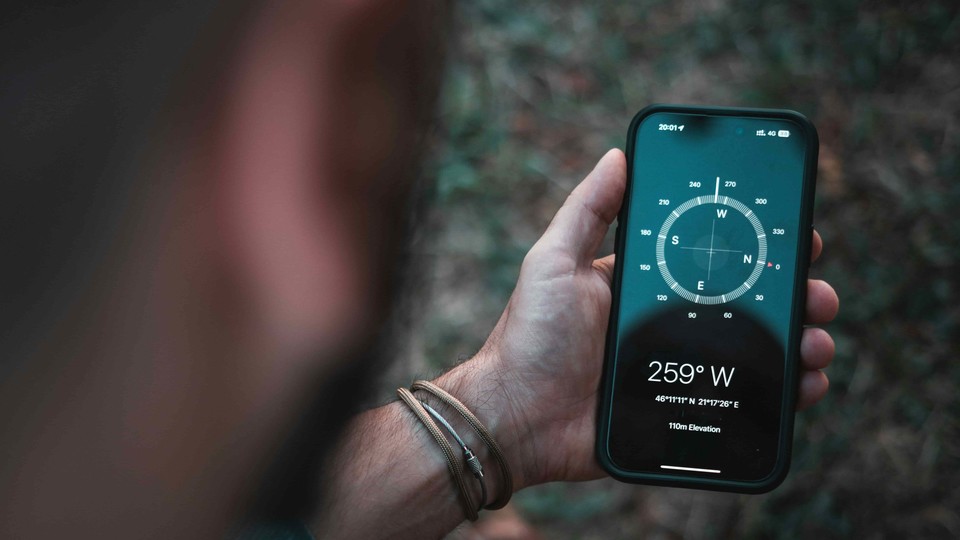
Groceries A La Cart
How We Get Our Groceries Is In Flux. Will Home Delivery Be The Future Of Food Shopping, Or A Flash In The Pan?
By Jennifer (Jennie) Latson
How We Get Our Groceries Is In Flux. Will Home Delivery Be The Future Of Food Shopping, Or A Flash In The Pan?
The future of grocery shopping could look something like what Cherise Osmon does every day.
On a recent Friday morning, in the produce section of the Montrose Whole Foods Market, Osmon opened the Instacart app on her iPhone and clicked “start shopping.” A countdown timer started and she was off, leaving amateur shoppers in her dust.
She picked up a pint of raspberries, inspected it, and set it in her cart. She weighed two organic apples and set them next to the raspberries. Then she made a beeline for the jam aisle, with a purposeful stride powered by an internal GPS for groceries. She knew this Whole Foods well; she’d already mapped her route in her head.
In the dairy section, she hit a roadblock. The 2 percent organic milk on her list wasn’t in stock. She paused to text the customer a question: Should she substitute 2 percent organic milk fortified with DHA Omega-3?
Her last stop was the freezer aisle, where she grabbed a bag of frozen berries and a loaf of gluten-free bread, and then she zipped to the cash register. This Whole Foods has a lane dedicated to Instacart shoppers, where a green-shirted “in-store” employee was already bagging groceries. There are enough orders at this Whole Foods alone to warrant a dedicated Instacart employee who does the shopping, the buying and the bagging for contract workers who will simply pick the groceries up and deliver them.
Instacart already employs about 650 shoppers in the Houston area (all but the in-store shoppers work as independent contractors). The online grocery business is good here — and some analysts say it’s likely to get better. Amazon’s recent acquisition of Whole Foods signaled the online retail behemoth’s commitment to a delivery-based model of grocery shopping. And Amazon isn’t the only one banking on this model. A report released earlier this year by Nielsen and the Food Marketing Institute predicts that by 2025, online spending could account for 20 percent of total U.S. grocery sales, representing $100 billion annually. That’s roughly five times its current share of 4.3 percent.
Younger people, especially, are gravitating toward options like Instacart, Amazon Fresh, Peapod and Shipt, Nielsen found. According to one survey, 30 percent of Millennials said they were already ordering groceries online for home delivery, compared to 22 percent of Gen X-ers and 17 percent of Baby Boomers. Analysts expect the number of younger shoppers who buy groceries online to increase in coming years.
As Nielsen points out, grocery delivery is not a new invention — the milkman was the Instacart of the 1950s, at least in a limited way. Today, however, the options are broader and the convenience greater. Osmon has lugged massive bags of dog food and buckets of kitty litter up several flights of stairs — not to mention cases of water and other family-size bundles from Costco. Instacart can also bring you beer, wine and liquor.
But some Rice Business professors believe the online future of grocery shopping may be overhyped. The dominant model of online grocery delivery, as it exists now, is far from efficient, says Scott Sonenshein, the Henry Gardiner Symonds Professor of Management at Rice.
Companies like Instacart and Shipt are sending employees into stores owned by other companies, and paying full retail price for goods — then adding a service charge and a delivery charge on top of that retail price. It’s a narrow profit margin for the delivery companies themselves, and a lot to ask of customers.
“My sense is that the Instacart model is really an intermediate step in this process,” Sonenshein said. “One challenge is that Instacart doesn’t know what the price will be in the stores they shop; there could be fluctuation, which could be a cause of concern for customers.”
AmazonFresh, meanwhile, could prove to be a more stable model. “They’re shopping from the Amazon warehouse, where they can control the supply chain, they can control things like the price. They’re not shopping retail in other people’s stores,” he said. “That looks a lot more like the future to me.”
Instacart does have partnerships with some retailers, including Whole Foods. But now that Amazon has acquired Whole Foods, Sonenshein points out, that partnership may be short-lived.
“I think it’ll take time to reach a point where more grocery shopping happens online than not,” Sonenshein says. “It’s still a rather small portion of the market, and grocery creates a lot more challenges than retail. For one thing, you have perishable goods; you also have a lot more variety of goods. At the grocery store, you like tomatoes to look and feel a certain way, and that’s going to create concerns for some customers. Eventually, as the cost comes down, the convenience can come to outweigh those concerns — it’s just going to have some challenges and take some more time.”
---
The challenges, for shoppers like Osmon, include balancing careful selection — getting tomatoes that look and feel right — with staggering speed.
Osmon tries to pick fruits and vegetables that are ripe and ready to be used that day, but not so ripe that they won’t last a few more days. If, say, a customer asks for avocados, but all the avocados on display are green and hard, Osmon will text to see whether the customer still wants them. She is especially careful with eggs — she picks up each egg in a carton to be sure none are cracked.
But she can’t dawdle. Instacart tracks employee speed metrics, and efficiency is at a premium. Osmon averages about 50 seconds per item, which puts her at the fast end of the employee spectrum. She acknowledges that the speed per item index lends itself to a spirit of competition; she doesn’t mind.
“It’s like a scavenger hunt for me,” she says.
There are inevitably speed bumps, especially on the busiest shopping days: Sunday and Monday. Even the best-planned trips can be derailed by an unfamiliar item, like the riced cauliflower she once scoured an entire store for.
Unfamiliar items also pose a challenge when it comes to acting as a customer’s surrogate. How do you pick the perfect jackfruit, for example, when you’ve never had a jackfruit? Instacart shopper Renee Smith solved the problem simply enough: She chatted up a produce associate and tried a sample.
“They taste good — a little like Juicy Fruit, the gum,” Smith says. “And I found out that the browner they are on the outside, the sweeter they are on the inside.”
Instacart shoppers are responsible for the care and safety of groceries from the time they add them to the shopping cart to the moment they’re delivered. This poses its own set of challenges, especially in Houston, where if it’s not the heat, it’s the crater-sized potholes.
“I run into the ice cream issue, especially if I’m doing multiple deliveries with ice cream in each one. In the Houston heat, that can be a problem,” Osmon said. She’s outfitted her trunk with specialized freezer canisters just for ice cream, separate from the larger cooler she uses for meat, dairy and other refrigerated items.
The potholes are another problem. “Eggs and bread always go in the front [passenger] seat, with me,” Osmon said. “And I always double-check my trunk to make sure nothing’s escaped from a bag. Sometimes there’s an onion on the loose.”
While shoppers like Osmon are undoubtedly fastidious, however, even the most efficient grocery delivery model won’t overcome one fundamental hurdle: many people prefer to shop for their own food. In predicting the future of grocery shopping, some analysts fail to factor in consumer psychology, according to Utpal M. Dholakia, a marketing professor at Rice Business.
“It seems to me that a large number of people — maybe a majority — are not ever going to shop for groceries online,” Dholakia said. “Shopping for groceries is fundamentally different from shopping for shoes or clothes or lightbulbs. There are many differences, but one is that people want to have that sensory connection with the product. This is fresh food, fresh produce; relying on someone to deliver bananas or tomatoes is not the same as getting them yourself.”
The way we shop for groceries is habitually ingrained, much more than buying books or clothes, Dholakia explained. How we buy food isn’t just a matter of cost and efficiency — it’s part of our lifestyle.
“If I enjoy going to the store and looking for deals, and think it’s an interesting and fun thing to do, there’s no amount of efficiency that’s going to change that,” he said. “I might try different products because they’re on sale, or see something that looks interesting in the store. And there’s the sampling that’s part of the grocery store experience. You can’t get any of that online.”
---
What you do get online is the convenience and ease of having someone else do your shopping. And that person is a pro, if Osmon and Smith are a fair representation. Of course, the drawback to being a pro shopper: If you look like you know what you’re doing, people are bound to ask you for help. At Whole Foods, an older man spotted Smith’s green Instacart shirt and mistook her for a store employee.
“Ma’am, you work here?” he asked.
“I don’t, but I might be able to help you,” she offered.
“Y’all moved the butters! I’m looking for the sunflower butter,” he said.
“I know where that is! Aisle 1,” she said, and led him there.
“I want the no-sugar, no-salt kind,” he said, and waited while she crouched to get him the right one from the bottom shelf.
“We get that a lot,” Smith said. One of the rewards of the job, she added, is bringing groceries to people who are elderly or disabled and for whom grocery shopping is either difficult or impossible.
Of course, they don’t mind if you use their services just because you don’t feel like shopping.
“What we offer is time,” Smith explained. “We give you that time back.”
Jennifer Latson is an editor at Rice Business Wisdom and the author of The Boy Who Loved Too Much, a nonfiction book about a rare disorder called Williams syndrome.
Never Miss A Story


